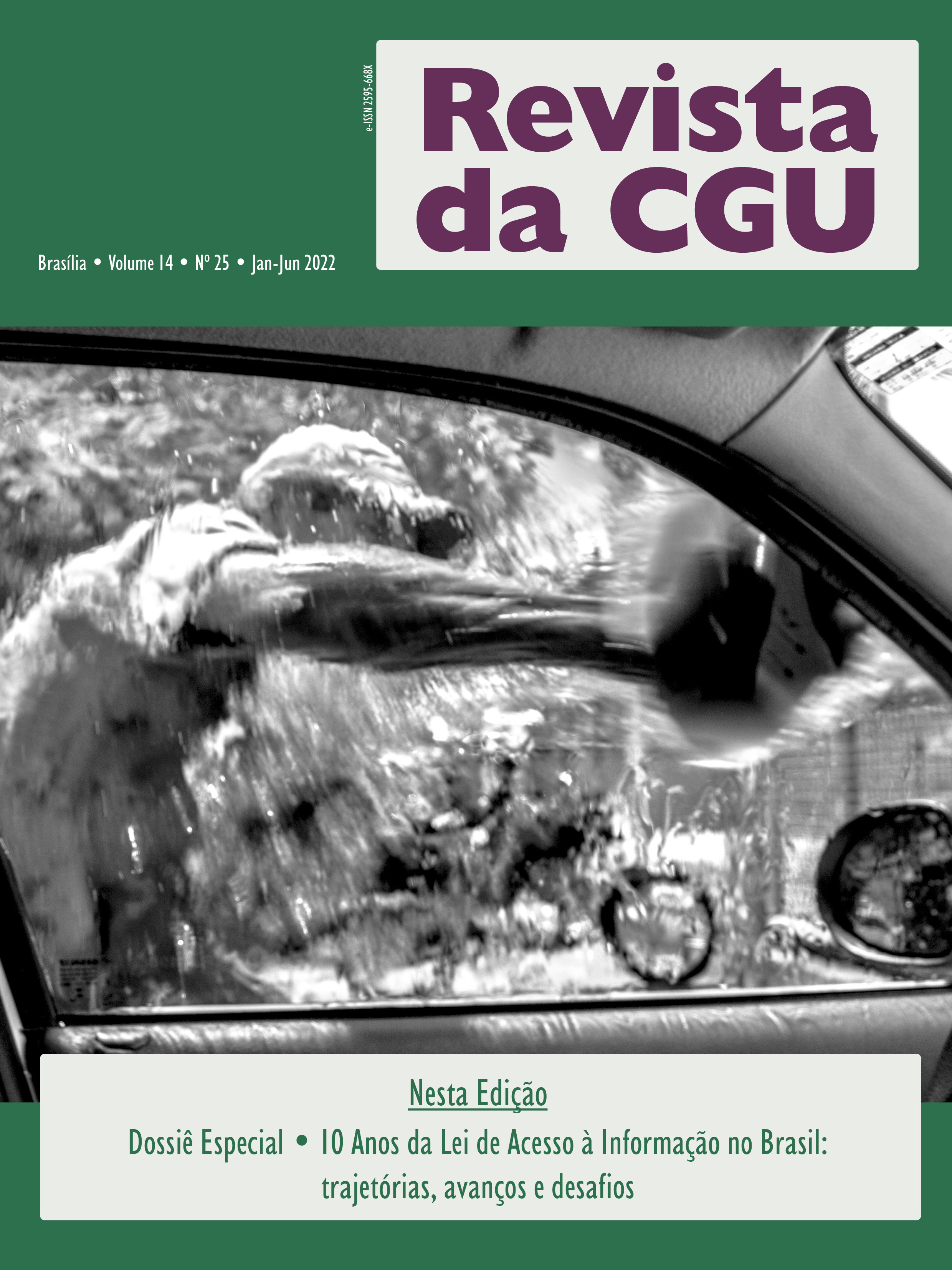Proposta de um indicador de corrupção no Brasil baseado em dados do Tribunal de Contas da União
DOI:
https://doi.org/10.36428/revistadacgu.v14i25.401Abstract
The objective of this work is to propose and build a Brazilian, objective and regional corruption indicator based on the register of accounts judged irregular by the Federal Court of Accounts (TCU). To this end, a literature review on the concept of corruption is initially made. The study is qualitative and quantitative, and uses Jurimetrics, which is Statistics applied to Law. The research uses documentary technique, and the electronic documents were collected on the website of TCU and the Brazilian Institute of Geography and Statistics (IBGE). The work is justified insofar as it is necessary to have a Brazilian, regional and objective indicator to allow comparisons between states and over time, to plan, analyze and control public policies to combat corruption. In the end, CIPM (irregular accounts per million inhabitants) is proposed as an indicator of corruption that meets the desired characteristics
Downloads
References
ACKERMAN, R. S. The economics of corruption: an essay in political economy. New York, Academie Press, 1978.
ALENCAR, C. H. R.; GICO Jr, I. Corrupção e judiciário: a (in)eficácia do sistema judicial no combate à corrupção. Revista Direito GV, São Paulo, v. 7, n.1, p. 075-098, 2011.
AMB. Juízes contra a corrupção. Brasília: Associação dos Magistrados Brasileiros, 2007.
AVRITZER, L.; FILGUEIRAS, F. Corrupção e controles democráticos no Brasil, Texto para Discussão, No. 1550, Instituto de Pesquisa Econômica Aplicada (IPEA), Brasília, 2011.
BEZERRA FILHO, A. A especialização da justiça para repelir a corrupção e promover a defesa do meio ambiente. Dissertação (mestrado) - Universidade Católica de Santos, Programa de Pós-Graduação stricto em Direito Internacional, 2020
BOBBIO, N.; MATEUCCI, N.; PASQUINO, G. Dicionário de política. 11. ed. Distrito Federal: UnB/Linha Gráfica Editora, 1998.
BOLL, J. L. S. A corrupção governamental no brasil: construção de indicadores e análise da sua incidência relativa nos estados brasileiros. Dissertação (Mestrado em Economia do Desenvolvimento). Faculdade de Administração, Contabilidade e Economia, Pontifícia Universidade Católica do Rio Grande do Sul, Porto Alegre, 2010.
BRASIL. LEI Nº 8.443, DE 16 DE JULHO DE 1992. Dispõe sobre a Lei Orgânica do Tribunal de Contas da União e dá outras providências. Disponível em: http://www.planalto.gov.br/ccivil_03/leis/l8443.htm. Acesso em: 17 out 2020.
BRASIL. Portaria nº 3.553, de 12 de novembro de 2019. Aprova o Regimento Interno e o Quadro Demonstrativo de Cargos em Comissão e das Funções de Confiança da Controladoria-Geral da União - CGU e dá outras providências. Controladoria-Geral da União, 2019.
BRASIL. Lista de responsáveis com contas julgadas irregulares. Tribunal de Contas da União. Disponível em: https://contasirregulares.tcu.gov.br/ordsext/f?p=105:1:::NO:2,3,4,5,6::. Acesso em: 18 fev 2021.
BRASIL. População. Instituto Brasileiro de Geografia e Estatística. Disponível em: https://www.ibge.gov.br/estatisticas/sociais/populacao.html. Acesso em: 19 fev 2021.
BREI, Z. A. Corrupção: dificuldades para definição e para um consenso. Revista de Administração Pública. Rio de Janeiro v. 30 n. 1. p. 64-77, 1996.
FILGUEIRAS, F. A tolerância à corrupção no Brasil. Uma antinomia entre normas morais e prática social. Opinião Pública, v. 15, n. 2, 2009.
JANNUZI, P. M. Indicadores sociais no Brasil: conceitos, fonte de dados e aplicações. Campinas: Alínea, 2001.
JANNUZI, P. M. Indicadores para diagnóstico, monitoramento e avaliação de programas sociais no Brasil. Revista do Serviço Público, Brasília, v.56, n.2, p.137-160, 2005.
MIRANDA, L. F. Unificando os conceitos de corrupção: uma abordagem através da nova metodologia dos conceitos. Revista Brasileira de Ciência Política, n. 25. Brasília, p. 237-272, 2018.
NYE, S. Corruption and political development: a coast-benefit analysis. American Political Science Review, v. 61, n. 2, p. 417-27, 1967.
SILVA, M. Corrupção: tentativa de uma definição funcional. Revista de Administração Pública. V. 28 n. 1, p. 18-23, 1994.
SOUZA, A. I.; ARAÚJO, M. P. Uma análise econômica da corrupção no Brasil a partir de indicadores objetivos e subjetivos 1998-2013. Revista Espacios. v. 38, n. 9, 2017.
TANZI, Vito. Corruption, Governmental Activities, and Markets. IMF Working Paper, 1994.
TRANSPARENCY INTERNATIONAL. What is corruption? Disponível em: https://www.transparency.org/en/what-is-corruption#. Acesso em 06 jan. 2021. 2021.
WORLD BANK. Helping countries combat corruption: the role of the World Bank. Washington, 1997, p. 8. Disponível em: http://www1.worldbank.org/publicsector/anticorrupt/corruptn/corrptn.pdf. Acesso em: 06 jan. 2021.
Downloads
Published
Issue
Section
License
Copyright (c) 2022 Revista da CGU

This work is licensed under a Creative Commons Attribution 4.0 International License.
The Revista da CGU follows the Creative Commons Attribution 4.0 International License (CC BY), which allows the use and sharing of published works with mandatory indication of authors and sources. Contents published until 2019 have generic permission for use and sharing with mandatory indication of authorship and source.
We highlight some essential and non-exhaustive points related:
- The submission of the proposal implies a commitment not to submit it to another journal and authorizes if approved, its publication.
- The submission of the proposal also implies that the author(s) agrees with the publication, without resulting in remuneration, reimbursement, or compensation of any kind.
- The published texts are the responsibility of the authors and do not necessarily represent the opinion of the journal.
- Responsibility for any plagiarism is the responsibility of the author(s).
- The person responsible for the submission declares, under the penalties of the Law, that the information on the authorship of the work is complete and correct.
Also highlighted are the items related to our Editorial Policies, in particular on the Focus and Scope, Publication Ethics, Peer Review Process, and Open Access Policy.


